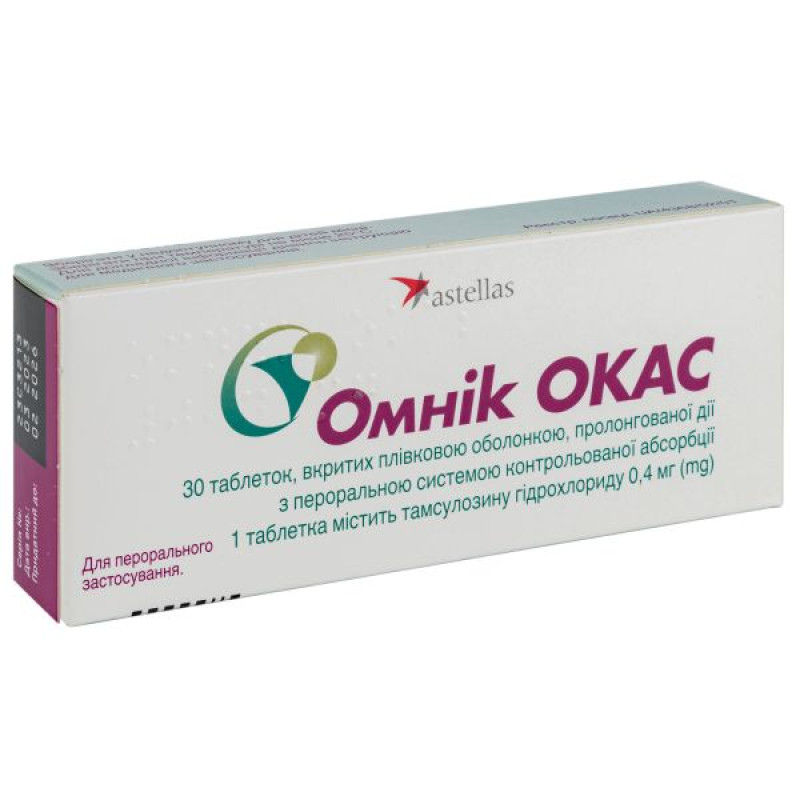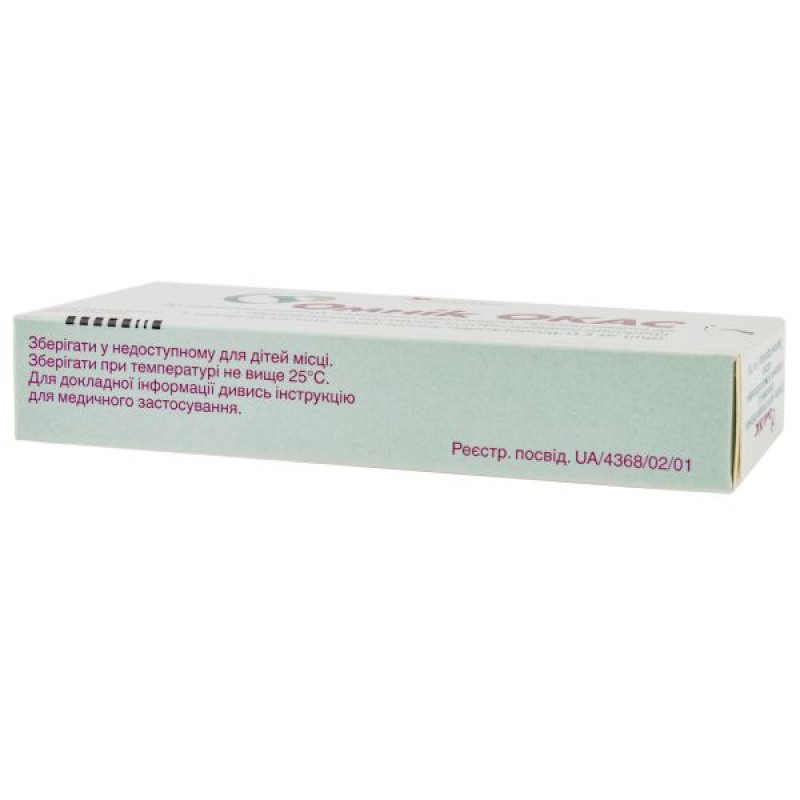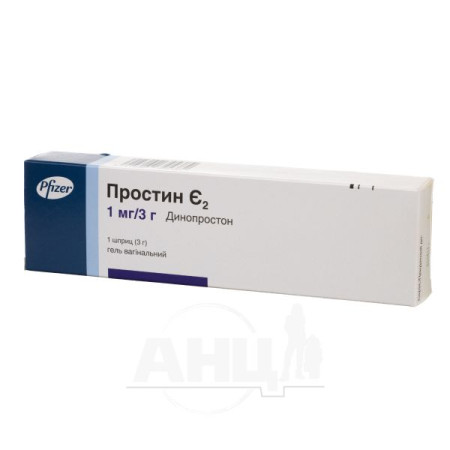Omnic Okas film-coated tablets with controlled release 0.4 mg No. 30

Instructions for Omnic Okas film-coated tablets with controlled release 0.4 mg No. 30
Composition
active ingredient: tamsulosin hydrochloride;
1 tablet contains 0.4 mg of tamsulosin hydrochloride;
excipients: macrogol 8000, macrogol 7000000, magnesium stearate, purified water, Opadry yellow 03F22733.
Dosage form
Film-coated, prolonged-release tablets with an oral controlled-absorption system.
Main physicochemical properties: tablets are round, biconvex, coated with a yellow film shell, marked with embossing "04".
Pharmacotherapeutic group
Drugs used in benign prostatic hyperplasia. α1-adrenergic receptor antagonists. ATC code G04C A02.
Pharmacological properties
Pharmacodynamics
Omnic Okas selectively and competitively blocks postsynaptic α1-adrenoceptors, in particular α1A and α1D, located in the smooth muscles of the prostate gland, bladder neck and prostatic urethra. This leads to a decrease in the tone of the smooth muscles of the prostate gland, bladder neck and prostatic urethra and an improvement in urine output.
At the same time, symptoms of obstruction and irritation associated with benign prostatic hyperplasia (difficulty starting urination, weak urine stream, dribbling after urination, feeling of incomplete bladder emptying, frequent urination, urge to urinate at night, urinary urgency) are reduced.
The ability of α1A-adrenergic blockers to reduce blood pressure is associated with a decrease in peripheral resistance. Omnic Okas at a daily dose of 0.4 mg does not cause a clinically significant decrease in systemic blood pressure (BP) in both patients with arterial hypertension and patients with normal initial BP.
Pharmacokinetics
Absorption. Omnic Okas is a prolonged-release tablet with controlled release based on a matrix using a non-ionic gel. The Okas form provides a long and slow release of tamsulosin, which gives exposure with weak fluctuations for 24 hours. After oral administration on an empty stomach, 57% of tamsulosin is absorbed in the intestine. The rate and extent of absorption of the drug in the dosage form of prolonged-release tablets do not change when taking a low-fat meal. Absorption rates increase by 64% and 149% (AUC and Cmax, respectively) when taking a high-fat meal compared to taking it on an empty stomach.
Tamsulosin exhibits linear pharmacokinetics.
After a single dose of Omnic Okas on an empty stomach, the maximum concentration of the active substance in the blood plasma is observed after 6 hours. In the equilibrium state, which is achieved on the fourth day of taking the drug, the peak concentration occurs after 4-6 hours, regardless of food intake. The peak concentration in the blood plasma increases from approximately 6 ng/ml after the first dose to 11 ng/ml in the equilibrium state.
As a result of the prolonged release, the lowest plasma concentration of tamsulosin is 40% of the maximum concentration regardless of food intake.
Distribution: Plasma protein binding is 99%. The volume of distribution is small (approximately 0.2 l/kg).
Metabolism. Tamsulosin hydrochloride has a low first-pass effect, being slowly metabolized. Most of the active substance is present in the blood in unchanged form. It is metabolized in the liver. In vitro results show that CYP3A4 and also CYP2D6 are involved in the metabolism, other CYP isoenzymes have little effect on tamsulosin. Inhibition of the metabolizing enzymes CYP3A4 and CYP2D6 may lead to increased exposure to tamsulosin hydrochloride (see sections "Special instructions for use", "Interaction with other medicinal products and other types of interactions"). None of the metabolites is more active than the active substance.
Elimination: Tamsulosin and its metabolites are excreted primarily by the kidneys, with 4-6% of the dose excreted unchanged. The half-life of tamsulosin after a single dose and at steady state is 19 and 15 hours, respectively.
Indication
Treatment of lower urinary tract symptoms in benign prostatic hyperplasia.
Contraindication
Hypersensitivity to tamsulosin hydrochloride, including drug-induced angioedema, or to any of the excipients; history of orthostatic hypotension; severe hepatic impairment.
Interaction with other medicinal products and other types of interactions
Interaction studies were conducted only in adults.
In in vitro studies, diazepam, propranolol, trichlormethiazide, chlormadinone, amitriptyline, diclofenac, glibenclamide, simvastatin and warfarin did not affect the free fraction of tamsulosin in human plasma. Similarly, tamsulosin did not change the free fractions of diazepam, propranolol, trichlormethiazide and chlormadinone in human plasma.
However, diclofenac and warfarin may increase the elimination rate of tamsulosin.
Concomitant use of tamsulosin hydrochloride with strong CYP3A4 inhibitors may lead to increased exposure to tamsulosin hydrochloride. Concomitant use with ketoconazole (a known strong CYP3A4 inhibitor) resulted in an increase in AUC and Cmax up to 2.8- and 2.2-fold, respectively.
Tamsulosin hydrochloride should not be administered in combination with strong CYP3A4 inhibitors in patients with poor CYP2D6 metabolism.
Tamsulosin hydrochloride should be used with caution in combination with strong and moderate CYP3A4 inhibitors.
Concomitant use of tamsulosin hydrochloride and paroxetine (a strong CYP2D6 inhibitor) resulted in an increase in Cmax and AUC of up to 1.3 and 1.6 times, respectively, but this is not clinically significant.
Concomitant use with other α1-adrenergic blockers may enhance the hypotensive effect.
Application features
As with other α1-adrenergic blockers, in some cases, when using the drug Omnic Okas, a decrease in blood pressure is possible, which rarely can lead to loss of consciousness. At the first signs of orthostatic hypotension (dizziness, weakness), the patient should sit or lie down and remain in this position until the above symptoms disappear.
Before starting treatment with Omnic Okas, you should undergo a medical examination to identify other concomitant diseases that may cause the same symptoms as benign prostatic hyperplasia. Before starting treatment, a rectal examination of the prostate gland and, if necessary, a test to determine the level of prostate-specific antigen (PSA) before starting and at regular intervals during treatment should be performed.
The drug should be prescribed with extreme caution to patients with severe renal insufficiency (creatinine clearance <10 ml/min), as clinical studies have not been conducted in such patients.
Some patients who have taken or are taking tamsulosin have experienced atonic pupil syndrome (IFIS, a variant of pinhole pupil syndrome) during cataract and glaucoma surgery, which may lead to an increased number of complications during or after such surgery.
It is generally recommended that tamsulosin be discontinued 1-2 weeks before cataract and glaucoma surgery, but the benefit of stopping tamsulosin has not been clearly established. Atonic pupil syndrome has also been reported in patients who have discontinued tamsulosin for a long period prior to cataract surgery.
Patients undergoing elective cataract or glaucoma surgery are not recommended to start taking tamsulosin hydrochloride. In order to prevent possible complications associated with IFIS, surgeons and ophthalmologists should inquire about the patient's history of taking tamsulosin when preparing for surgery.
Tamsulosin hydrochloride should not be administered in combination with strong CYP3A4 inhibitors in patients with poor CYP2D6 metabolism.
Tamsulosin hydrochloride should be used with caution in combination with strong and moderate CYP3A4 inhibitors (see Interactions with other medicinal products and other forms of interaction).
Sometimes you can find tablet residue in the feces.
Cases of allergic reactions to tamsulosin have been reported in patients with a history of allergy to sulfonamides. Caution should be exercised when administering tamsulosin hydrochloride to patients with a history of allergy to sulfonamides.
Ability to influence reaction speed when driving vehicles or other mechanisms
Studies on the effect of the drug on the ability to drive or use machines have not been conducted. However, patients should be warned about the possibility of dizziness.
Use during pregnancy or breastfeeding
Omnic Okas is not indicated for use in women.
Fertility
Ejaculation disorders have been reported in short- and long-term clinical trials with tamsulosin. Cases of ejaculation disorders, retrograde ejaculation and insufficient ejaculation have been reported in the post-marketing period.
Method of administration and doses
The recommended dose is 1 tablet daily, regardless of meals. The tablet should be swallowed whole, without breaking or chewing it, as this will interfere with the long-term and controlled release of the active ingredient. The duration of treatment is determined individually.
No dose adjustment is required in patients with renal impairment. No dose adjustment is required in patients with mild to moderate hepatic impairment (see also section "Contraindications").
Children
The drug is not used in children.
The safety and efficacy of tamsulosin in children have not been evaluated.
Overdose
Overdose with tamsulosin hydrochloride can potentially cause severe hypotensive effects. Severe hypotensive effects have been observed with varying degrees of overdose.
Treatment.
In case of a sharp decrease in blood pressure due to overdose, supportive therapy should be carried out, aimed at restoring normal cardiovascular function (for example, the patient should be placed in a horizontal position). If this measure is ineffective, infusion therapy and vasopressors should be prescribed. It is necessary to monitor renal function and carry out general supportive therapy. Given the high degree of binding of tamsulosin to plasma proteins, it is unlikely that hemodialysis is advisable.
To stop further absorption of the drug, vomiting can be induced artificially. In case of a significant overdose of the drug, the patient should be washed with activated charcoal and low-osmotic laxatives, such as sodium sulfate.
Adverse reactions
| Body system | Common (>1/100, <1/10) | Uncommon (>1/1000, <1/100) | Rare (>1/10,000, <1/1,000) | Very rare (<1/10,000) | Unknown (cannot be estimated from available data) |
| Neurological disorders | Dizziness (1.3%) | Headache | Faint | ||
| From the organs of vision | Blurred vision*, visual impairment* | ||||
| From the heart | Feeling of heart palpitations | ||||
| Vascular disorders | Orthostatic hypotension | ||||
| Respiratory-mediastinal disorders | Rhinitis | Nosebleed* | |||
| Gastrointestinal disorders | Constipation, diarrhea, nausea, vomiting | Dry mouth* | |||
| Skin and mucous membrane disorders | Rash, itching, hives | Angioedema | Stevens-Johnson syndrome | Erythema multiforme*, exfoliative dermatitis*, photosensitivity reaction* | |
| Reproductive disorders | Ejaculation disorders, including retrograde ejaculation and ejaculatory failure | Priapism | |||
| General disorders | Asthenia |
* Observed in the post-registration period.
During post-marketing surveillance, cases of intraoperative iris instability (pinched pupil syndrome) during cataract and glaucoma surgery have been described in patients taking tamsulosin (see section "Special warnings and precautions for use").
Post-marketing experience: In addition to the above adverse reactions, cases of atrial fibrillation, arrhythmia, tachycardia and dyspnoea have been reported. These cases were reported spontaneously, the frequency of reports and the role of tamsulosin in their occurrence cannot be reliably established.
Expiration date
3 years.
Storage conditions
Keep out of reach of children.
Store at a temperature not exceeding 25 ºС.
Packaging
10 tablets in a blister, 3 blisters in a cardboard box.
Vacation category
According to the recipe.
Producer
Astellas Pharma Europe B.V.
Location of the manufacturer and its business address
Astellas Pharma Europe B.V.: Hogemat 2, 7942 JM Meppel, The Netherlands.
There are no reviews for this product.
There are no reviews for this product, be the first to leave your review.
No questions about this product, be the first and ask your question.







